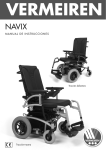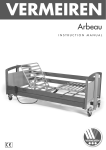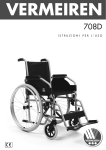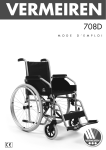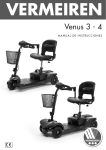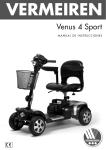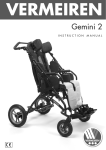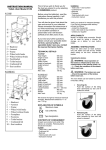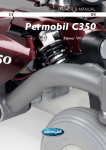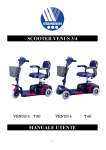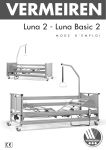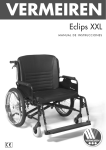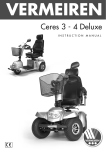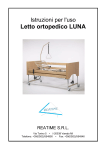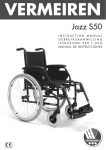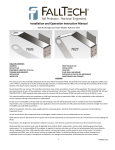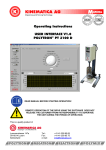Download Instruction manual (single version)
Transcript
VERMEIREN NAVIX INSTRUCTION MANUAL Front wheel drive Rear wheel drive Instructions to the specialist dealer This instruction manual is part and parcel of the product and must accompany every product sold. Version: F, 2015-08 All rights reserved, including translation. No part of this manual may be reproduced in any form what so ever (print, photocopy, microfilm or any other process) without written permission of the publisher, or processed, duplicated or distributed by using electronic systems. © N.V. Vermeiren N.V. 2015 Navix 2015-08 Contents 1 1.1 1.2 1.3 1.4 1.5 1.6 2 2.1 2.2 2.3 2.4 2.5 2.6 2.7 2.8 2.9 2.10 2.11 2.12 2.13 2.14 2.15 2.16 2.17 2.18 2.19 2.20 2.21 2.22 2.23 3 3.1 3.2 3.3 3.4 3.5 3.6 4 Product description .............................................................................................................3 Intended Use ............................................................................................................... 3 Technical specifications .............................................................................................. 4 Components ................................................................................................................ 7 Accessories ................................................................................................................. 8 Explanation of symbols .............................................................................................. 8 Safety instructions ...................................................................................................... 9 Use .........................................................................................................................................10 Remarks on electromagnetic compatibility (EMC) .................................................. 10 Carrying the electric wheelchair ................................................................................11 Assembly and disassembly of the electric wheelchair ..............................................11 Mounting or Fold away armrest ............................................................................... 13 Adjusting of the armrests .......................................................................................... 13 Mounting or removing of the footrests ..................................................................... 14 Folding the back of the wheelchair........................................................................... 14 Back inclination ........................................................................................................ 15 Mounting or removing the seat frame ...................................................................... 15 Seat cushions ............................................................................................................ 17 Back rest cushions .................................................................................................... 17 Transfer in and out the electric wheelchair............................................................... 17 Correct position in the electric wheelchair ............................................................... 18 Driving the electric wheelchair................................................................................. 18 Operating the brakes ................................................................................................. 18 Driving the electric wheelchair on ramps ................................................................. 21 Pushing the wheelchair ............................................................................................. 21 Transport in the car ................................................................................................... 22 Transport in an airplane ............................................................................................ 23 Batteries .................................................................................................................... 24 Battery charger.......................................................................................................... 24 Charging the batteries ............................................................................................... 24 Blow fuse .................................................................................................................. 25 Installation and adjustment .............................................................................................25 Tools ......................................................................................................................... 25 Manner of delivery ................................................................................................... 25 Possible adjustments ................................................................................................. 26 Changing the batteries .............................................................................................. 30 Battery connections .................................................................................................. 30 Tyre changing ........................................................................................................... 31 Maintenance ........................................................................................................................32 Page 1 Navix 2015-08 Preface First of all we want to thank you for putting your trust in us by selecting one of our products. The expected lifetime of your electric wheelchair is strongly influenced by the care and maintenance of the wheelchair. This manual will help you get acquainted with the operation of your electric wheelchair. Following of the user instructions and the maintenance instructions are an essential part of the warranty. This manual reflects the latest product developments. Vermeiren has the right to introduce changes without the obligation to adapt or replace previously delivered models. For any further questions, please consult your specialist dealer. Page 2 Navix 2015-08 1 Product description 1.1 Intended Use The electric wheelchair Navix is equipped with two motors, of 220W. The electric wheelchair Navix is intended to comfortably transport persons with walking difficulties or no walking abilities. This electric wheelchair is designed to transport 1 person. The electric wheelchair is designed to transport persons only, no goods. Neither should it be used by persons obviously suffering from physical or mental limitations (e.g. visual impairment, ...) that render them incapable of safely handling the electric wheelchair. The different types of fittings and accessories, and the modular construction allow full use by persons disabled by: paralysis loss of limbs (leg amputation) limb defects or deformations stiff or damaged joints heart insuffiencies and poor blood circulation balance disturbances cachexia (decrease in muscle) The electric wheelchair is classified as class A. The electric wheelchair is a front wheel drive wheelchair or rear wheel drive wheelchair depends on your purchase. The electric wheelchair is suited for indoor and outdoor use by the occupant. The user can operate the wheelchair by himself or have the wheelchair pushed by an attendant with the push bar. When providing for individual requirements: body size and weight (max. 130 kg) physical and psychological condition residential circumstances environment should be taken into consideration. Your electric wheelchair should be used on flat surfaces where all four wheels are touching the ground and where there is sufficient contact to operate the wheelchair safely. You should practice for use on uneven surfaces (cobblestones, etc.), slopes, curves and to get past obstacles (curbs, etc.). A particular risk is involved when crossing surfaces such as ice, grass, rubble, foliage, etc. The electric wheelchair should not be used as a ladder, nor is it a transport for heavy or hot objects. When using your electric wheelchair on streets or footpaths, local laws and regulations apply. The electric wheelchair can be used on sidewalks, urban road. Under no circumstances the electric wheelchair may be used for driving on larger roads or expressways. Use only Vermeiren approved accessories. The manufacturer is not liable for damage caused by the lack of improper service or as a result of not following instructions from this manual. Visually impaired people can contact the dealer for the instructions for use. Page 3 Navix 2015-08 1.2 Technical specifications Technical terms below are valid for the electric wheelchair in standard settings without seat cushion and optimum environmental conditions. If accessories are used, the tabulated values will change. Changes in outdoor temperatures, humidity, uphill's, downhill's, soils and battery levels can reduce output. Brand Vermeiren Address Vermeirenplein 1/15, B-2920 Kalmthout Type Electric wheelchair, Class A Model Navix (Front wheel drive) Maximum occupant mass 130 kg Description Effective seat width Dimensions 400 mm (Adjustable 0 - 50 mm) Overall width (depends on the seat width) Description 450 mm (Adjustable 0 - 50 mm) 580 mm 630 mm Dimensions Minimum Max. speed Continuous driving distance range* 500 mm (Adjustable 0 - 50 mm) Dimensions Maximum 6 km/h Approx. 20 km (38Ah) / Approx. 32 km (50Ah) Overall length with footrest 1058 mm Overall height 956 mm Folded / dismantled length (without footrest) Lower frame: 690 mm; Seat frame: 600 mm Folded / dismantled width Lower frame: 570 mm; Seat frame: 560 mm Folded / dismantled height Lower frame: 325 mm; Seat frame: 400 mm Total mass Mass of heaviest part (that can be dismantled or removed) Masses of parts that can be dismantled or removed. 78,80 kg Lower frame + armrest + joystick (without batteries): 31,65 kg Armrest: 0,95 kg; Footrests: 1,90 kg; Seat frame: 17,05 kg; Lower frame + armrest + joystick: 31,65 kg; Batteries: 27,15 kg Static stability downhill 15° Static stability uphill 15° Static stability sideways 15° Maximum safe slope 9° Obstacle climbing 50 mm Ground clearance 60 mm Seat plane angle Effective seat depth 5° 10° 380 mm 500 mm Thickness seat cushion Seat surface height at front edge 40 mm 400 mm 500 mm 0° 40° Backrest angle Backrest height Distance between footrest and seat 580 mm 330 mm Angle footrest Distance between armrest and seat 12° 260 mm Front location of armrest structure 350 mm 410 mm Driving motors Batteries 400 mm SRG05 / 2 x 220W 2 x 12V Page 4 AGM / 38 Ah or 50 Ah / 20 hr Navix 2015-08 Brand Vermeiren Address Vermeirenplein 1/15, B-2920 Kalmthout Type Electric wheelchair, Class A Model Navix (Front wheel drive) Maximum occupant mass 130 kg Description Dimensions Minimum Battery charger Dimensions Maximum See separate user manual of the battery charger 8A; IP21; Insulation class II Blow fuse 150 AMP Control unit See separate user manuals of the operator controls / Electromagnetic braking system Degree of protection IPX4 Minimum turning diameter 1250 mm Reversing width 1250 mm Diameter Rear wheels (number) 200 x 50 mm (2) Tyre pressure, rear wheels Max. 2.5 bar Diameter front wheels (number) 317.5 x 57.15 mm air (2) Tyre pressure, front wheels Max. 2.5 bar Noise level < 65 dB (A) Storage and use temperature +5 °C to +41 °C Operating temperature of the electronics -10°C to +40°C Storage and use humidity 30% 70% We reserve the right to introduce technical changes. Measurement tolerance ± 15 mm / 1,5 kg / ° . * The theoretical driving distance will be reduced if the wheelchair is used frequently on slopes, rough ground or to climb curbs. Table 1: Technical specifications front wheel drive Brand Vermeiren Address Vermeirenplein 1/15, B-2920 Kalmthout Type Electric wheelchair, Class A Model Navix (Rear wheel drive) Maximum occupant mass 130 kg Description Effective seat width Dimensions 400 mm (Adjustable 0 - 50 mm) Overall width (depends on the seat width) Description 580 mm 500 mm (Adjustable 0 - 50 mm) 630 mm Dimensions Minimum Max. speed Continuous driving distance range* 450 mm (Adjustable 0 - 50 mm) Dimensions Maximum 6 km/h Approx. 20 km (38Ah) / Approx. 32 km (50Ah) Overall length with footrest 1010 mm Overall height 995 mm Folded / dismantled length (without footrest) Lower frame: 780 mm; Seat frame: 600 mm Folded / dismantled width Lower frame: 570 mm; Seat frame: 560 mm Folded / dismantled height Lower frame: 325 mm; Seat frame: 400 mm Total mass Mass of heaviest part (that can be dismantled or removed) 78,80 kg Lower frame + armrest + joystick (without batteries): 31,65 kg Page 5 Navix 2015-08 Brand Vermeiren Address Vermeirenplein 1/15, B-2920 Kalmthout Type Electric wheelchair, Class A Model Navix (Rear wheel drive) Maximum occupant mass 130 kg Description Masses of parts that can be dismantled or removed. Dimensions Minimum Dimensions Maximum Armrest: 0,95 kg; Footrests: 1,90 kg; Seat frame: 17,05 kg; Lower frame + armrest + joystick: 31,65 kg; Batteries: 27,15 kg Static stability downhill 15° Static stability uphill 15° Static stability sideways 15° Maximum safe slope 9° Obstacle climbing 50 mm Ground clearance 60 mm Seat plane angle Effective seat depth 5° 10° 380 mm 500 mm Thickness seat cushion 40 mm Seat surface height at front edge 400 mm 500 mm 0° 40° Backrest angle Backrest height 580 mm Distance between footrest and seat 330 mm Angle footrest 400 mm 12° Distance between armrest and seat 260 mm Front location of armrest structure 350 mm 410 mm Driving motors SRG05 / 2 x 220W Batteries 2 x 12V Battery charger AGM / 38 Ah or 50 Ah / 20 hr See separate user manual of the battery charger 8A; IP21; Insulation class II Blow fuse 150 AMP Control unit See separate user manuals of the operator controls / Electromagnetic braking system Degree of protection IPX4 Minimum turning diameter 1250 mm Reversing width 1250 mm Diameter Rear wheels (number) 317.5 x 57.15 mm air (2) Tyre pressure, rear wheels Max 2.5 bar Diameter front wheels (number) 200 x 50 mm (2) Tyre pressure, front wheels Max. 2.5 bar Noise level < 65 dB (A) Storage and use temperature +5 °C to +41 °C Operating temperature of the electronics -10°C to +40°C Storage and use humidity 30% 70% We reserve the right to introduce technical changes. Measurement tolerance ± 15 mm / 1,5 kg / ° . * The theoretical driving distance will be reduced if the wheelchair is used frequently on slopes, rough ground or to climb curbs. Table 2: Technical specifications rear wheel drive Page 6 Navix 2015-08 The wheelchair complies to the requirements set up in: ISO 7176-8: Requirements and test methods for static, impact and fatigue strengths. ISO 7176-14: Wheelchairs - Part 14: Power and control systems for electrically powered wheelchairs and scooters -- Requirements and test methods ISO 7176-21: Wheelchairs - Part 21: Requirements and test methods for electromagnetic compatibility of electrically powered wheelchairs and motorized scooters. ISO 7176-16: Wheelchairs - Part 16: Resistance to ignition of upholstered parts -Requirements and test methods 1.3 Components Front wheel drive 1 = Push bar 2 = Back cushion 3 = Back frame 4 = Armpads 5 = Armrests 6 = Battery cover 7 = Lower frame 8 = Forks 9 = Steering wheels (rear wheels) 10 = Driving motors 11 = Driving wheels (front wheels) 12 = Operator control 13 = Seat cushion 14 = Seat frame 15 = Footrests 16 = Identification plate Rear wheel drive 1 = Push bar 2 = Back cushion 3 = Back frame 4 = Armpads 5 = Armrests 6 = Battery cover 7 = Lower frame 8 = Forks 9 = Driving wheels (rear wheels) 10 = Driving motors 11 = Steering wheels (front wheels) 12 = Operator control 13 = Seat cushion 14 = Seat frame 15 = Footrests 16 = Identification plate 17 = Anti-tipping Page 7 Navix 2015-08 1.4 Accessories The following accessories are available for the electric wheelchair Navix: Table (B13, B15) Adjustable leg-rest (BZ7) Electronic adjustable leg-rest (BZ7-E) Different seat and back cushions; Fixed back/seat (L14/L15), Soft comfort back/seat (L34/L35) Head rest (L55) only available with fixed back Pelots (side supports) for stability (L04) only available with fixed back Pelvic safety belt (B58) Anti-tipping device (B78) Lighting Electrical back inclination, seat inclination, lift 1.5 Explanation of symbols Maximum mass Limited indoor and outdoor use Indoor use (only for battery charger) Separate recovery and recycling of electric and electronic devices (only for battery charger) Protection class II Maximum safe slope CE conformity Maximum speed Position: Parking brakes activated (electric driving possible) Position: Parking brakes deactivated (free running and pushing possible, no electric driving) During free running, be careful with slopes and inclinations Not intended to be used as a seat in a Motor vehicle Type designation Page 8 Navix 2015-08 1.6 L L L L L L L L L L L L L L L L L L L L L L L L L L L Safety instructions When getting into and out of the wheelchair, do not stand on the footrests. The footplate should be folded up beforehand. Investigate the effects of shifting the centre of gravity on the behavior of the wheelchair, for example on up or down gradients, on laterally sloping ground, or when overcoming obstacles. Obtain support from an attendant. If you want to pick up something (lying in front of, on the side, or to the rear of the wheelchair), you should not lean too far out to avoid tipping over. When moving through doors, arches, etc. ensure that there is enough room at the sides so that you do not get your hands or arms caught or crushed and that there is no damage to the wheelchair. Avoid uncontrolled rolling against obstacles (steps, curbs, doorframes, etc) or dropping down from ledges. The manufacturer cannot assume liability for damage caused by overloading, collision or other improper use. When moving in public places, you are subject to local regulations. Influence of medicine or alcohol reduces your driving capabilities. When travelling outdoors, adapt your driving to weather and traffic conditions. Do not use your electric wheelchair in rainy conditions. Do not put your electric wheelchair into the free-wheeling position on slopes. Never reverse uphill. Reduce speed when you go round corners. To be better visible when driving in the dark, wear the brightest possible clothing or clothes with reflectors and make sure that the reflectors of the wheelchair are clearly visible and drive with lightning on. Make sure that the lights and reflectors of your electric wheelchair are free from dirt and/or other objects that could hide them. When transporting the wheelchair, never pick it up by grasping movable parts (wheels, seat cushion, etc.) When transporting the electric wheelchair, no persons may be transferred along with it. No additional passengers may be taken. When storing or parking your electric wheelchair outside, protect it with a shrouding cover against humidity. High levels of humidity or very cold conditions can reduce the performance of your electric wheelchair. Never use your electric wheelchair as a seat in an automobile or other vehicle. Never exceed the maximum load of 130 kg. Use only Vermeiren approved accessories. Before getting on or off, taking apart or transporting your electric wheelchair, put your wheelchair off with "ON/OFF" button. Check that the profile depth of the tyres is adequate. If your electric wheelchair has pneumatic tyres, be careful to inflate them to the correct pressure (see pressure indication on the tyres). If devices and furnishings like ramps or lifts are available, use them. Mount the seat frame during assembly correct on the lower frame for the front wheel and rear wheel drive wheelchair. Footrests must be on the same side as the thermal fuse on the battery cover. Otherwise the driving software, program of your wheelchair is not working correct. Page 9 Navix 2015-08 2 Use This chapter describes the everyday use. These instructions are for the user and the specialist dealer. To find a service facility or specialist dealer near you, contact the nearest Vermeiren facility. A list of Vermeiren facilities can be found on the last page. The electric wheelchair is delivered fully assembled by your specialist dealer. The instructions intended for the specialist dealer on how to set up the electric wheelchair are given in § 3. 2.1 Remarks on electromagnetic compatibility (EMC) Your electric wheelchair has been tested according ISO 7176-21 for EMC-compliance. We wish to point out that sources of electromagnetic waves are liable to create interferences. The electronics of the wheelchair itself could affect other electric appliances too. To reduce the effect of electromagnetic sources of interference, please read the following warnings: L WARNING: The wheelchair might disturb the operation of devices in its environment that emit electromagnetic field. L WARNING: The driving performance of the wheelchair can be influenced by electromagnetic fields (e.g. electricity generators or high power sources). L WARNING: Avoid using any portable TV or radio in the immediate environment of your wheelchair for as long as it is turned on. L WARNING: Avoid using any transmitter-receiver in the immediate environment of your wheelchair for as long as it is turned on. L WARNING: Check the area for transmitter masts and avoid using the wheelchair close to them. L WARNING: If involuntary movements or braking occur, turn off the wheelchair as soon as it is safe to do so. Interfering electromagnetic fields may have a negative effect on the wheelchair’s electronic systems. These can include: Disengagement of the engine brake Uncontrollable behavior by the wheelchair Unintentional steering movements In the presence of very strong or enduring interfering fields, the electronic systems could even break down entirely or suffer permanent damage. Page 10 Navix 2015-08 Possible sources of radiation include: Portable receiver and transmitter installations (receiver and transmitter with fixed antenna) - Transmitting and receiving sets - Portable TV, radio and navigation devices - Other personal transmitting devices - Mobile medium-range transmitting and receiving devices (e.g. car antennas) Fixed transmitting and receiving sets Fixed mobile transmitting and receiving devices Fixed radio, TV and navigation systems - Long-range transmitting and receiving devices Radio and television towers Amateur radio sets - Other home devices CD player Notebook Microwave oven Cassette recorder etc. Devices like electric shavers and hair dryers will have no influence provided that they function perfectly and their cabling be in an excellent condition. Please conform to the operating instructions accompanying such electric instruments to ensure trouble free operating of your wheelchair. 2.2 Carrying the electric wheelchair The best way to carry the electric wheelchair is to make use of free-wheel mode of the electric wheelchair. Place the wheelchair in free-wheel mode and roll the wheelchair with the push bar to the desired place. When the wheelchair must be taken up or down stairs, do this with the wheelchair ramps or lift systems. At least two persons are required to move the wheelchair up or down stairs or over single steps. Another way to carry the electric wheelchair is to dismantle the electric wheelchair. Carry the separate parts (seat frame, lower frame, armrests, footrests, batteries) to the desired place. 2.3 Assembly and disassembly of the electric wheelchair The electric wheelchair is delivered fully assembled. Your dealer delivers the wheelchair fully assembled and explains the various operating elements and their use. However, for your own safety we provide a further, detailed explanation of the different parts. The pictures below are for the front wheel drive wheelchair. For the rear wheel drive you can use the same instructions. Mount the seat frame during assembly correct on the lower frame for the front wheel and rear wheel drive wheelchair. Footrests must be on the same side as the thermal fuse on the battery cover. Otherwise the driving software, program of your wheelchair is not working correct. Page 11 Navix 2015-08 2.3.1 Disassembly of the electric wheelchair To disassembly the electric wheelchair: 1. 2. 3. 4. 5. 6. 7. 8. 9. 10. Fold up the footplates of the footrests. Remove the footrests (paragraph 2.6). Remove armrest with joystick (paragraph 2.5). Remove other armrest (paragraph 2.5). Fold up the back (paragraph 2.7). Remove the seat frame from the lower frame (paragraph 2.9). Remove the first battery out the battery cover. (paragraph 3.4). Slide the second battery to the front and remove the second battery (paragraph 3.4). Put the armrest with the joystick on the lower frame. Lift the disassembled parts to the desired place. 2.3.2 Assembly of the electric wheelchair To assembly the electric wheelchair: 1. Remove the armrest with the joystick out of the lower frame. 2. Place the first battery in the battery cover and slide these to the back (paragraph 3.4). 3. Place the second battery in the battery cover (paragraph 3.4). 4. Place the seat frame on the lower frame (paragraph 2.9). 5. Unfold the back (paragraph 2.7). 6. Mount the armrest (paragraph 2.5). Page 12 Navix 2015-08 7. 8. 9. Mount the armrest with joystick (paragraph 2.5). Mount the footrests (paragraph 2.6). Fold the footplates of the footrests down. 2.4 Mounting or Fold away armrest L CAUTION: Risk of clamping – Keep fingers, buckles and clothes away from the attachment points of the armrest or armpad. The armrests can be fold away so the patient can be moved sideways. To mount the armrests on the electric wheelchair: 1. Turn the armrest to the front around the pivot point . 2. Pull on lever . 3. Mount the tube hood in hole . To fold away the armrests from the electric wheelchair: 1. Pull on lever . 2. Turn the armrest backwards around the pivot point until it stops. 2.5 Adjusting of the armrests L WARNING: Risk of tipping over - Check that the armpads are at the same height on each side. The armpads are adjustable in 7 different heights. Height armpad Position tube Ⓒ 260 mm Hole 7 275 mm Hole 6 290 mm Hole 5 305 mm Hole 4 320 mm Hole 3 335 mm Hole 2 350 mm Hole 1 Table 3: Armrest height 1. Loosen the locking mechanism slightly by turning the star knob Ⓐ anti-clockwise. 2. Pull on the locking pin Ⓐ. 3. Move the square tubes Ⓑ and Ⓒ over each other to adjust the armpad height. Do this at the same time when pulling on the locking pin Ⓐ. 4. Loosen the locking pin Ⓐ. 5. Check that the locking pin Ⓐ is securely fixed. 6. Retighten the locking mechanism by turning the star knob Ⓐ clockwise to reduce the play of the armrest. These instructions can also used for removing the armpads. Page 13 Navix 2015-08 2.6 Mounting or removing of the footrests The wheelchair has two footrests that can be fold away to the "outside" with a 3 point attachment system (, , on the figure below). This system provides a stady, play-free connection of the footrest to the seat frame. The mounting of the footrests is done as follows: 1. Hold the footrest sideways at the outside of the wheelchairs frame and mount the pins into the holes . 2. Turn the footrest inwards till the pin click in the hole of the attachment point . 3. Turn the footplates downwards. To take off the footrests: 1. Fold the footplates upwards. 2. Pull or push on lever . 3. Turn the footrest to the outside of the wheelchair until the hole comes loose of the pin from attachment point . 4. Pull the footrest upwards until the pins come out of the holes . 2.7 Folding the back of the wheelchair L WARNING: Risk of injury – Make sure that both safety pins are engaged. L CAUTION: Chance of pinching – Do not place fingers between the components of the wheelchair. For transport the back of the wheelchair can be completely folded to the seat. 1. Pull gently on the back strap . 2. The safety pins of the back come loose . 3. Fold the backrest forward . Page 14 Navix 2015-08 To unfold the backrest: 1. Pull gently on the back strap. 2. Pull to the backrest until it clicks into position. 3. Be sure that both safety pins click in the holes of the backrest adjustment plate. 2.8 Back inclination Make sure that the backrest is on both sides placed in the same position for the comfort of the patient. The angle of the back can be adjusted from 90° - 130°. Angle of back Position on backrest plate Ⓐ 90° Hole 1 100° Hole 2 110° Hole 3 120° Hole 4 130° Hole 5 Table 4: Angle of backrest 1. 2. 3. Pull on the back strap Ⓑ until the locking pins Ⓒon both sides come out the hole of the backrest Ⓐ. Push or pull the backrest forward or backwards until the desired angle. Check that the locking pins Ⓒ are securely fixed. 2.9 Mounting or removing the seat frame L WARNING: Risk of injury – Check that the seat frame clicks in the two front hooks while mounting. Risk of clamping – Keep fingers, buckles and clothes away from the attachment points of the seat frame. L CAUTION: The mounting of the seat frame is done as follows: Page 15 Navix 2015-08 1. Slide the front tube of the seat frame Ⓐ over the front hooks Ⓑ until the front seat tube Ⓐ fall in the groove of the front hooks Ⓑ. The seat frame clicks automatically in the correct place. 2. Now place the back tube of the seat frame Ⓒ in the back hooks Ⓓ. 3. Click the red buckles Ⓔ upwards until they are mounted around the back tube of the seat frame Ⓒ. These red buckles Ⓔ are located on the back of the wheelchair frame. To take off the seat frame: 1. Click the red buckles Ⓐ downwards until they are removed from the back tube of the seat frame Ⓒ. 2. Remove the seat frame from the lower frame by grasping on the fixed parts of the seat frame. Do not use the foot-, arm rests or back rest to grasp the seat frame. Lift the back tube of the seat frame Ⓒ out the hooks Ⓓ. 3. Pull the seat frame backwards until the front tube of the seat frame Ⓐ comes out the groove of the front hooks Ⓑ. 4. Now lift the front tube of the seat frame Ⓐ out the front hooks Ⓑ. Page 16 Navix 2015-08 2.10 Seat cushions The seat cushion can be removed or mounted with the velcro strips on the seat frame plate . 2.11 Back rest cushions L WARNING: Risk of injury – Check that all straps are secured with Velcro. The back rest cushions can be removed or mounted with the velcro strips on the backrest velcro straps . The back can be adjusted in its flexibility, so the back of the user is supported differently. 1. Remove the back rest cushion with the velcro . Pull the back rest cushion on the frontside to the front, back rest cushion comes from the velcro straps . Pull the back rest cushion on the back side backwards. Now you can see the suspension system with straps that can be adjusted independently. 2. Loosen the velcro closures of the respective straps . 3. Pull the respective strap to the desired position, the tension of the individual belts can be varied and the desired support of the back can be set. 4. Replace the back rest cushion . 2.12 Transfer in and out the electric wheelchair L CAUTION: In case you cannot perform the transfer in a safe manner, ask L L someone to assist you. CAUTION: Risk of injury – Do not use the joystick, footplates, armrests as support. CAUTION: Risk of tipping over of the wheelchair – Do not stand on the foot plates. 1. Park the electric wheelchair as close as possible to the place where you want to transfer. 2. Check that the operator control is switched off. Make sure that the wheelchair is NOT in freewheel mode. 3. Fold the footplates upwards to prevent standing on them. 4. If the transfer is on the side of the wheelchair, fold the armrest on that side away. 5. Transfer to / from the electric wheelchair. Page 17 Navix 2015-08 2.13 Correct position in the electric wheelchair Some recommendations for a comfortable use of the electric wheelchair: 1. Position your backside as close as possible to the back rest. 2. Make sure your upper legs are horizontal – If needed adjust the length of the foot rests. 2.14 Driving the electric wheelchair L WARNING: Risk of burns – Be careful when driving in hot or cold environments L (sunshine, extreme cold, etc.) for a sufficient amount of time and when touching - Surfaces can assume the environment temperatures. WARNING: Risk of unsafe settings - Use only the driving characteristics described in this manual. 2.14.1 Preparing the electric wheelchair for use When you start using your electric wheelchair, make sure that it is standing on level ground. All wheels must be in contact with the ground. 1. Make sure that the freewheel mode is OFF and the operator control is switched off. 2. Adjust the wheelchair best suited for yourself. 3. Set the operator control in the most comfortable position. 4. Sit down on the seat and verify that both armpads have been adjusted so your forearms are folded down. 5. Put your wheelchair on with the "ON/OFF" button from the operator control. Now put the speed control on the operator control to the minimum position. Your electric wheelchair is now ready for use. 2.14.2 Handling after usage Before getting off from your electric wheelchair, make sure that all four wheels touch the ground simultaneously. Push on the "ON/OFF" button from the operator control, the display of the operator control goes out. 2.15 Operating the brakes Let go of the joystick to stop the electric wheelchair. 2.15.1 Parking the electric wheelchair Once your electric wheelchair has been turned off, no command can be sent to the driving system. Always park your electric wheelchair on sites that are easy accessible and on horizontal surfaces that the four wheels are touching the ground. 2.15.2 Operator controls The instructions for use from the operator controls you can find in the seperate user manals of the operator controls that is included with your wheelchair. Changing the software is only allowed by Vermeiren. For changes in the software contact Vermeiren. Page 18 Navix 2015-08 2.15.3 Adjusting operator control The operator control's horizontal position can be changed: 1. Loosen screw just under the arm rest a little bit. 2. Move the operator control to the desired position or remove the operator control. 3. Retighten screw properly. 2.15.4 Connections for charger / program unit L WARNING: Risk of injury - Check that all plugs (battery charger and programming unit) are removed before setting the wheelchair in motion. The socket for connecting the charger supplied is located on the front of the operator control. Here, too, is the connnection for the programming unit, which should only be connected and used by authorised persons who have been trained to program it (Vermeiren personnel). 2.15.5 Your first trip L WARNING: Control your electric wheelchair - Accustom yourself with the driving behavior of your electric wheelchair. Driving Once you are seated on your electric wheelchair and have started it as described above, take the joystick with your hand and push this in the required direction i.e.: PUSH ACTION FORWARD PUSH ACTION BACKWARD = = FORWARD MOVEMENT BACKWARD MOVEMENT Braking To brake, let go of the joystick, which will let it return to the zero position and slow down your electric wheelchair to a gentle stop. Practice pulling away and braking to get accustomed to the electric wheelchair. You need to be able to estimate how your electric wheelchair will react when you drive or brake. Driving in corners and bends L WARNING: Risk of tipping over - Reduce your speed before you enter a curve or corner. L WARNING: Risk of clamping - Always maintain an adequate distance from corners and obstacles. L WARNING: Risk of injury - Be careful with the front wheel drive wheelchair, the rear of the wheelchair can swing while turning. Move the joystick into the position you wish to turn. The steering wheels will turn accordingly and steer the electric wheelchair into a new direction. It is very important that you ensure that there is enough space allowing you to go around bends and corners. Narrow passages must preferably be approached in a large curve so as to allow you to enter the narrowest part as straight from the front as possible. Page 19 Navix 2015-08 Take care not to enter curves and corners diagonally. By ‘cutting the corner’, chances are that your rear wheels, back of wheelchair will run into obstacles and destabilize your electric wheelchair. 2.15.6 Backward movement L WARNING: Control your electric wheelchair - Accustom yourself with the driving behavior of your electric wheelchair. L WARNING: Control your speed - Always go backward in the lowest speed possible. L WARNING: Risk of collision - Always look to the back when you go backward. Rearward driving requires increased concentration and care. This explains why we have greatly reduced the speed of rearward movement in comparison with forward driving. But we still recommend that you put the speed on minimum when you drive backward. Left and right controls act inverse when driving backwards. 2.15.7 Going uphill L WARNING: Control your electric wheelchair - Accustom yourself with the driving behavior of your electric wheelchair. L WARNING: Control your electric wheelchair - Never put your electric wheelchair L L L in freewheel on slopes. WARNING: Control your speed - Move on slopes as slow as possible. WARNING: Risk of tipping over - Do not exceed the maximum gradient of static and dynamic stability uphill (see paragraph "Technical specifications") WARNING: Never reverse going uphill. Always approach slopes directly from the front and, to avoid tipping over, see that all four wheels stay in contact with the ground at all times (ramps, driveways, etc.). If you come to a stop on a slope by letting go of the joystick, the engine break will prevent your electric wheelchair from rolling backward. As soon as the joystick returns to zero position, the engine break is activated. To resume your uphill drive, push the joystick as much as possible to the front to ensure the release of a sufficient amount of power. This will allow your electric wheelchair to slowly ascend the slope. If your wheelchair is unable to drive up, turn the speed control up and try again. 2.15.8 Going downhill L WARNING: Control your electric wheelchair - Accustom yourself with the driving behavior of your wheelchair. L WARNING: Control your wheelchair - Never put your electric wheelchair in L L L neutral on slopes. WARNING: Control your speed - Move on slopes as slow as possible. WARNING: Risk of tipping over - Avoid sharp bends. WARNING: Risk of tipping over - Do not exceed the maximum gradient of static and dynamic stability downhill (see paragraph "Technical specifications") Page 20 Navix 2015-08 Always approach downhill slopes directly from the front. Slantwise approaches can lead to some of the wheels no longer staying in contact with the ground (danger of tipping over). The weight of the electric wheelchair will increase your downhill speed. Lower the speed on the operator control. Avoid sharp bends on downhill slopes. The weight of your electric wheelchair could cause your electric wheelchair to lift up on one side or even fall over around bends. 2.16 Driving the electric wheelchair on ramps L WARNING: Risk of injury - Do not exceed the maximum load of the ramps. L WARNING: Risk of injury - Choose the correct ramps to prevent injury or damage. L WARNING: Risk of injury - Be sure that the wheel height is high enough to get L L over the free height of the ramps. The electric wheelchair frame may not touch the ramps. WARNING: Risk of injury - Use a restraining safety belt to secure yourself in your wheelchair. WARNING: Risk of tipping over - Put the adjustment functions (seat, back, footrests, ...) so that the wheelchair has the best stability. Should you wish to use ramps to drive over an obstacle, please note the following: 1. Find out from the manufacturer what the maximum load is for the ramps. 2. Drive on the ramps at the lowest speed possible. 3. See the instructions in the chapter "your first trip". If the wheelchair has adjustment functions, ensure that (because these has influence on the stability of the electric wheelchair): 1. The seat is in the lowest position as possible and in the horizontal position. 2. The back is in the upright position. 3. The footrests have been set so that no collision can occur while passing the obstacle. If another person is pushing you, note that the large weight of the electric wheelchair exerts appreciable reverse forces. 2.17 Pushing the wheelchair L WARNING: Control your electric wheelchair - Never put your electric wheelchair L in neutral while you are driving. WARNING: Control your electric wheelchair - Never put your electric wheelchair in neutral on slopes. It may accidentally roll away. The wheelchair is fitted with a freewheel device that is accessible and operable only by the attendant. Page 21 Navix 2015-08 2.17.1 220W motors-6km/h Put the chair in neutral with the adjusting levers on both motors. Clutch or declutch the motor by following the instructions below: DRIVING Push the adjusting levers of both motors in the position of the symbol for driving. Switch the operator control out and in. Electronically controlled driving is now possible. NEUTRAL Pull the adjusting levers of both motors in the position of the symbol for neutral and you will activate the wheelchair's free-running mode. The wheelchair can now be pushed without electronic drive. In free wheel mode, the electronic brake is deactivated and the wheelchair will no longer be held back. Do not activate free wheel mode on slopes. L You should only use free-running to transport the wheelchair or to move it out of a danger zone. L When free-running is activated, the electromagnetic braking system is deactivated, so the wheelchair is no longer secured against rolling away. Take care not to set the wheelchair down on slopes or uneven terrain, or it may accidentally roll away. L The electonic system will indicate, through the lock symbol flashing, that electronic driving is not possible. 2.18 Transport in the car L DANGER: Risk of injury - The electric wheelchair is not suited for use as a seat in a motor vehicle. Risk of injury - No people or objects should be under the electric wheelchair, during transportation. WARNING: Risk of injury - See that the wheelchair is attached properly. So you can avoid injury from the passengers during collision or sudden braking. WARNING: Risk of injury- Use for attaching the wheelchair and passenger NEVER the same seatbelt. L WARNING: L L Never use your wheelchair as a seat in an automobile or other vehicle. The wheelchair shall be marked with following symbol. To transport the wheelchair in the car use following steps: The best way to transport your electric wheelchair in the car is to drive the electric wheelchair in the car by using ramps. When you are not experienced to drive the electric wheelchair by using of ramps you can also put the wheelchair in neutral mode and push the wheelchair in the car by using ramps. Page 22 Navix 2015-08 When the wheelchair does not fit in the car it is also possible to transport the wheelchair by the following steps: 1. Remove all moveable parts prior to transporting (footrests, armpads, operator control, seat frame, lower frame, etc.). 2. Store moveable parts safely. 3. Place the electric wheelchair in the car with 2 persons by grasping to the fixed parts of the frames. 4. Attach the frame securely to the vehicle with the transporthooks (see picture). 5. Place the wheelchair in drive mode (engage the parking brakes) and check that the operator control is switched off. 2.19 Transport in an airplane The electric wheelchair can be transported in an airplane. Electric wheelchairs shall be checked at the desk. Announce the wheelchair on time by the concern airline before departure. Do not use the electric wheelchair as a seat in an airplane, the wheelchair must be stored in the cargo room. To transport the wheelchair in an airplane note the following requirements: 1. Type and properties of wheelchair (joystick, batteries) The wheelchairs shall be foreseen of dry or gel batteries. Mostly these batteries must not be removed out the wheelchair. Only disconnect and insulate the electrical connections on the battery. 2. Dimensions and weight of the wheelchair The allowable weight and dimensions of the wheelchair depends on the type of the airplane. 3. Damage on the wheelchair It is possible that the wheelchair could be damaged because the wheelchair will be stored in a narrow area with the suitcases and other goods. To prevent damage on the wheelchair: Put the electrical adjustments in standard position (lift column as low as possible, seat inclination horizontal, back inclination the most foreward). Fold the footplates upwards, place the armsupports in the most inward position. Check that the adjustment levers shall positioned inwards. Cover the operator control with an soft material that can withstand shocks. Page 23 Navix 2015-08 Before travelling contact the concerned airline about the requirements for transporting the wheelchair in an airplane. 2.20 Batteries The standard for your electric wheelchair is two closed, 12 V/38 Ah or 50 Ah batteries. The batteries used with your electric wheelchair are drive batteries which only attain full capacity after a few charging and use cycles. If the batteries loose their power after long usage, or if they are damaged, get them both replaced by a specialist dealer only. We accept no liability for damage caused through using other types of batteries. If the batteries are opened, all manufacturer liability and all claims will become void. Do not use the batteries at temperatures below +5°C or above +50°C (the ideal is: +20°C). 2.21 Battery charger To charge the batteries, only use the battery charger supplied. For the user instructions of the battery charger you can refer to the manual that is delivered with your battery charger. 2.22 Charging the batteries L CAUTION: Risk of injury - Only use the battery charger supplied to charge batteries. As the charger aligns the charge curve with the AGM batteries' charge level, you can recharge your wheelchair after each use. This avoids any aggressive battery charging and the "memory effect". Recharge the wheelchair, at the latest, when the charge indicator on the steering unit goes into the red zone. If, despite this, you continue driving, eventually only the last red diode lights up and flashes continually, indicating that the batteries are nearly flat. If you disregard this warning signal, too, an error message will shortly appear indicating that the batteries can no longer provide power for driving. The batteries should therefore be charged before these error messages appear, using the supplied battery charger. Avoid the batteries becoming drained, in any case. FIRST USE First put the plug into the wall socket. After an LED combination has lit up, the charger switches to STANDBY. Both LEDs (green and yellow) are active. Next, connect the charger cable with the three-pin plug to the loader socket on the electric wheelchair's operator control. Once connected to the batteries, the charger automatically begins charging. Now only the yellow LED is active. When charging is complete, the yellow LED goes out and the green LED comes on. Now remove the charger cable from the operator control. The charger switches back to STANDBY mode (yellow and green LEDs active). If the charger cable is not removed, a tiny current will keep the batteries topped up (trickle charging). If you decide not to use your electric wheelchair for an appreciable period, you must nevertheless recharge it regularly to keep it in a running condition ready for immediate use. The manufacturer accepts no liability for damage caused by improper charging. For further information, please refer to the user instructions provided with the charger. Page 24 Navix 2015-08 2.23 Blow fuse To protect the motor against overload, there is a heat monitoring system located in the power module that will automatically cut off the motor to 1 prevent overheating and thus rapid wear and tear or breakdowns. This can occur if you go up or down slopes that exceed the maximum gradient indicated. Nominal loads exceeding the maximum could also trigger the safety mechanism. 2 To indicate that the motor is overloaded, there is a fault code on the operator control. This code comprises of: 1: Battery indicator flickering in sequence from left to right. 2: All LEDs of the speedindicator flickering at the same time. To be able to use the electric wheelchair again, place joystick in neutral, remove the overload and wait till the motor has cooled down. Your wheelchair is now ready for use again. To protect the wheelchair against short circuit, a blow fuse is located on the battery compartment. When there is short circuit in the wheelchair, the blow fuse melts. There will be no function, no identification anymore. Contact your specialist dealer. 3 Installation and adjustment The instructions in this chapter are for the specialist dealer only. The Navix has been designed as a front wheel drive electric wheelchair. The advantage of this wheelchair is a better maneuverability. These wheelchair is also available in a rear wheel drive model. L WARNING: Risk of unsafe settings - Use only the settings described in this manual (hardware and software). L WARNING: Risk of tipping over - Variation allowed adjustments can still change the stability of your wheelchair (tilt back or sideways). 3.1 Tools The Vermeiren Navix shall need following tools: Wrench set n° 10 to n° 19 Allen keyset n° 3 to n° 5 Screwdriver Phillips head 3.2 Manner of delivery The electric wheelchair shall be delivered with: 1 seat and lower frame with armrests, operator control, rear and front wheels 1 pair of footrests 2 x drive batteries, 2 x drive motors Charger + manual of charger Electronics Tools Operator control + manual operator control Accessories Before use, check that everything is included and that no products are damaged (example by transport, ...). Page 25 Navix 2015-08 3.3 Possible adjustments L WARNING: Risk of injury - Turn the electric wheelchair off before you perform any adjustments. L WARNING: Risk of injury - Never perform any adjustments while you are driving. L WARNING: Risk of injury - Adjustments may only performed by your specialist dealer. L WARNING: Risk of injury - Make sure all screws, handles are firmly secured L before driving with your electric wheelchair. CAUTION: Risk of clamping – Keep fingers, buckles and clothes away from the attachment points or any moving parts. 3.3.1 Adjusting the seat height and angle L WARNING: Risk of injury - Never change the seat height or angle when the user is sitting in the wheelchair. The Vermeiren Navix is adjustable in 3 different seat heights by changing the position of the front plates Ⓐ and the back plates Ⓑ of the seat frame upwards or downwards. Seat height without seat cushion Position front plate Ⓐ and back plate Ⓑ 400 mm Hole 1 450 mm (Standard) Hole 2 500 mm Hole 3 Table 5: Seat height 1. Remove the screw Ⓒ from the front plates Ⓐ of the seat frame. 2. Place the seat height in the desired position by mounting the connection bar for seat inclination Ⓔ in the right hole of the front plates Ⓐ (refer to table 5). 3. Retighten the screw Ⓒ properly. 4. Remove the screws Ⓓ from the back plates Ⓑ of the seat frame on each side. 5. Place the seat height in the desired position by mounting plate Ⓕ of the lower frame in the right hole of the back plates Ⓑ. 6. Retighten the screws Ⓓ properly. The Vermeiren Navix is adjustable in 3 different seat angles by changing the position of the connection lath for seat inclination Ⓐ. Seat angle Position connection bar for seat inclination Ⓐ 5° (standard) Hole 1 7,5° Hole 2 10° Place the connection bar for seat inclination Ⓐ with the holes positioned as shown on the figure. Page 26 Hole 3 Table 6: Seat angle Navix 2015-08 L WARNING: Risk of injury - Perform the adjustment of the seat angle with 2 persons or place something between the seat frame and lower frame. L WARNING: Risk of injury - Keep fingers, buckles and clothes away from the attachment points of the seat frame. 1. One person shall hold the seat frame upwards or place something between the seat frame and lower frame to avoid that the seat frame can fall down. 2. Loosen screw Ⓑ from the front plate a little bit so it will be possible to rotate the bar Ⓐ around these attachment point. 3. Remove the screw Ⓒ from the connection bar for seat inclination Ⓐ. 4. Place the seat angle in the desired position by position the connection bar Ⓐ in the right position (refer to table 6). 5. Retighten the screws Ⓑ, Ⓒ properly. 3.3.2 Adjusting the seat depth L WARNING: Risk of injury - Never change the seat depth when the user is sitting in the wheelchair. The Vermeiren Navix is adjustable in different seat depths over a range of 380 mm to 500 mm. 1. Remove the seat cushion with the velcro straps. 2. Loosen the hexagon socket set screws Ⓒ just under the seat frame. 3. Loosen the screw Ⓓ on the seat plate a little bit. 4. Place the seat plate in the correct seat depth by moving the square tubes Ⓐ and Ⓑ over each other. 5. Retighten the screws Ⓒ, Ⓓ properly. 6. Replace the seat cushion with the Velcro straps. The seat depth dimension you can read on the seat plate Ⓔ. The head of the screw Ⓓ shall give the seat depth dimension. Page 27 Navix 2015-08 3.3.3 Adjusting the seat width L WARNING: Risk of tipping over - Check that the armrests and footrests are positioned identically on each side. The seat width can be adjusted over a range of 50 mm by moving the armrests and footrest in horizontal direction. * Adjusting armrests: 1. Loosen the hexagon socket set screws Ⓐ just under the seat frame on each side. 2. Move the armrest in an horizontal direction until the correct seat with, by moving the square tubes Ⓑ and Ⓒ over each other. 3. Retighten the screws Ⓐ properly. 4. Repeat instructions above for the other armrest. The maximum position of the seat width is marked with the triangle on the square tube Ⓐ. Place the point of the triangle against the square tube Ⓑ mounted on the seat frame. The minimum position of the seat width is when the triangle edge of part Ⓐ is against the square tube Ⓑ mounted on the seat frame. Page 28 Navix 2015-08 * Adjusting footrests: 1. Loosen the hexagon socket set screws Ⓐ just under the seat frame on each side. 2. Move the footrest in an horizontal direction until the correct seat with, by moving the square tubes Ⓑ and Ⓒ over each other. 3. Retighten the screws Ⓐ properly. 4. Repeat instructions above for the other footrest. The maximum position of the seat width is marked with the triangle on the square tube Ⓐ. Place the point of the triangle against the square tube Ⓑ of the seat frame. The minimum position of the seat width is with a safe distance of 10 mm between the square tubes Ⓐ and Ⓑ. 3.3.4 Adjusting of the footrests Height footrest Position Outer tube Ⓐ Position inner tube Ⓑ 330 mm Hole 1 Hole 3 355 mm Hole 1 Hole 2 380 mm Hole 1 Hole 1 365 mm Hole 2 Hole 3 390 mm Hole 2 Hole 2 415 mm Hole 2 Hole 1 400 mm Hole 3 Hole 3 425 mm Hole 3 Hole 2 450 mm Hole 3 Hole 1 Table 7: Lengths of footrest for seat height 450 mm and seat angle 5°. Page 29 Navix 2015-08 Adjust the length of the footrests as follow: 1. Remove the screw Ⓒ. 2. Adjust the length of the footrest to a comfortable length according table 7. 3. Tighten the screw Ⓒproperly. Check that the footrests are positioned identically on both sides. 3.4 Changing the batteries L CAUTION: Risk of burns - Do not come in contact with the acid from the batteries. See for a good ventilation of the battery compartment. The battery shall be changed by trained personel. The battery can be changed according following steps. 1. Remove the seat frame (paragraph 2.10) 2. Disconnect all the wires on the batteries. 3. Lift the first battery out the battery housing . 4. Slide the second battery forward and take it out the battery housing . 5. Take the new batteries. 6. Place the first battery in the battery housing and push it backwards. 7. Place the second battery in the battery housing . 8. Connect all the wires to the batteries. 9. Replace the seat frame (paragraph 2.10) 3.5 Battery connections 1 = Battery 12 V 2 = Blow fuse 3 = Battery connection plug 4 = Plug operator control = Black cable = Red cable 1 1 3 3 2 4 Page 30 Navix 2015-08 3.6 Tyre changing L CAUTION: There must be no air in the tube before the tyre can be removed. L CAUTION: Risk of damage - If handled improperly, the rim might become damaged. Only an expert can guarantee correct assembly. Work not done by your specialist dealer, would void any warranty claims. Use only inflating equipment which complies to regulations and indicates the pressure in bar. We do not accept any liability for damage caused by using inflation equipment or wheels not supplied by the manufacturer. L WARNING: Risk of injury - Check that the pressure is correct. L CAUTION: Risk of injury - Make sure that no objects, body parts or inner tubes are pinched between the tyre and the rim when mounting a tyre. Driving wheels / Steering wheels Removing tyre from rim: 1. Let all the air out of the tube. 2. Insert a tyre lever between the tyre and the rim. 3. Slowly and carefully push the lever downwards. This will pull the tyre over the edge of the rim. 4. Move the lever along the rim, the tyre will jump out. 5. Now carefully remove the tyre from the rim and then remove the tube. Note the following before inserting the new tube: Check the rim bed and the inside wall of the tyre for foreign matter and clean these properly if necessary. Check the condition of the rim bed, especially around the position of the air valve. Please use only genuine original replacement parts. No liability is accepted for damage caused by non-genuine replacement parts. Kindly contact your specialist dealer. Assembly tyre from rim: Put the deflated tube around the center of the rim. Make sure that the valve juts out the valve opening in the rim. Push the tyre over the edge of the rim, starting behind the air valve. Inflate the tube slightly until it is round, and place it inside the tyre. If the tube fits snugly inside the tyre without any folds (in the case of folds: let out some air), then the upper side of the tyre can be pressed lightly onto the rim with both hands, starting at the air valve. Page 31 Navix 2015-08 Check all around on both sides that the tube is not pinched between the rim and the edge of the tyre. Lightly push the air valve inwards and pull it out again to make sure that the tyre is positioned properly in the region of the air valve. To ensure that the wheel is inflated correctly, admit only so much air initially that the tyre can still be easily pushed inwards by using your thumbs. If the check-lines are equidistant from the edge of the rim on both sides of the tyre, then the tyre is centered properly. If not - let out the air and position the tyre afresh. Now the tyre can be inflated to its full operating pressure (note the maximum) and the valve cap should be replaced. When inflating the tyres, always check that the pressure is correct. The correct pressure is given on the tyre sides. 4 Maintenance For the maintenance manual of the electric wheelchairs refer to the Vermeiren website: www.vermeiren.be. Page 32 Navix 2015-08 SERVICE The electric wheelchair was serviced: Dealer´s stamp: Dealer´s stamp: Date: Date: Dealer´s stamp: Dealer´s stamp: Date: Date: Dealer´s stamp: Dealer´s stamp: Date: Date: Dealer´s stamp: Dealer´s stamp: Date: Date: Dealer´s stamp: Dealer´s stamp: Date: Date: For service checklists an additional technical information, please see our specialist dealers nearest to you. More information on our website at: www.vermeiren.com. Germany N.V. Vermeiren N.V. Vermeirenplein 1 / 15 B-2920 Kalmthout Tel: +32(0)3 620 20 20 Fax: +32(0)3 666 48 94 website: www.vermeiren.be e-mail: [email protected] Vermeiren Deutschland GmbH Wahlerstraße 12 a D-40472 Düsseldorf Tel: +49(0)211 94 27 90 Fax: +49(0)211 65 36 00 website: www.vermeiren.de e-mail: [email protected] France Austria Vermeiren France S.A. Z. I., 5, Rue d´Ennevelin F-59710 Avelin Tel: +33(0)3 28 55 07 98 Fax: +33(0)3 20 90 28 89 website: www.vermeiren.fr e-mail: [email protected] Vermeiren Austria GmbH Schärdinger Strasse 4 A-4061 Pasching Tel: +43(0)732 37 13 66 Fax: +43(0)732 37 13 69 website: www.vermeiren.at e-mail: [email protected] Italy Switzerland Vermeiren Italia Vermeiren Suisse S.A. Viale delle Industrie 5 I-20020 Arese MI Tel: +39 02 99 77 07 Fax: +39 02 93 58 56 17 website: www.reatime.it e-mail: [email protected] Hühnerhubelstraße 59 CH-3123 Belp Tel: +41(0)31 818 40 95 Fax: +41(0)31 818 40 98 website: www.vermeiren.ch e-mail: [email protected] Poland Spain / Portugal Vermeiren Polska Sp. z o.o ul. Łączna 1 PL-55-100 Trzebnica Tel: +48(0)71 387 42 00 Fax: +48(0)71 387 05 74 website: www.vermeiren.pl e-mail: [email protected] Vermeiren Iberica, S.L. Carratera de Cartellà, Km 0,5 Sant Gregori Parc Industrial Edifici A 17150 Sant Gregori (Girona) Tel: +34 972 42 84 33 Fax: +34 972 40 50 54 website: www.vermeiren.es e-mail: [email protected] Czech Republic Vermeiren ČR S.R.O. Nadrazni 132 702 00 Ostrava 1 Tel: +420 596 133 923 Fax: +420 596 133 277 website: www.vermeiren.cz e-mail: [email protected] R.E.: N.V. Vermeiren N.V., Vermeirenplein 1/15 - 2920 Kalmthout - Belgium – 2015-08- Instruction Manual Navix- vF Belgium




































